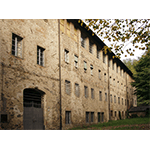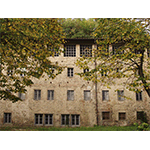Centro di Documentazione sulla Lavorazione della Carta - Museo della Carta [Documentation Centre on Paper Manufacture - Paper Museum]
Several paper-mills perhaps already existed upstream of the city of Pescia in the Middle Ages, though certain news of their presence is recorded only in following centuries. It was mainly in the second half of the 18th century, with the abolition of the monopoly on paper by Grand Duke Francis Stephen of Lorraine, that the factories of Pescia exceeded in number and importance those of Colle di Val d’Elsa, which had long been the capital of paper production. So it was that in the 19th century, Pescia became the most important paper producing centre in the Grand Duchy.
For motive power, the paper-mills used the water of the Pescia stream by means of a dense network of canals and millraces. The raw materials were rags, mainly made of hemp and linen, and carnicci, that is to say the fragments of flesh that remained attached to animal hides. Drafted around 1820, the "Regolamento dell’arte della carta all’uso di Toscana con i suoi rispettivi scandagli tratti dagli usi antichi e moderni soliti praticarsi negli edifizi di Pescia in Toscana e nello Stato di Genova", indicates the machinery, working methods, and division of labour within a paper-mill. In a factory with a single vat, for example, the ground floor was utilised for the pulp-making tanks, the vat and boiler. On the second floor were lodged the "ripper" to tear the rags, the workshops and accommodations for the "pulp-making tank deputy"; on the third floor were the lodgings for the workers and the director; on the forth floor was the spreader, a single large room with very large windows, where the sheets of paper were placed to dry.
In 1992, the Documentation Centre on Paper Manufacture was founded in order to document this historical manufacturing activity. Later, it set up a fascinating museum divided into two centres: the Documentation Centre on Paper Manufacture, which exhibits educational models of machinery, and the former "Le Carte" paper-mill, which conserves old devices (several of which date to the 18th century) for the handcrafted production of special papers.
The collection consists of equipment and machinery (vats, rag-grinding pulp-making tanks, machinery for the preparation of mixtures, hand-presses, a screw-press and a water turbine) utilised at the "Le Carte" paper-mill. On the ground floor, the facilities occupy their original location. The collection also includes hand-operated machines for making paper, such as ruling machines and shears, in addition to filigrees and models of excellent quality papers, including the one chosen by Napoleon Bonaparte for his wedding invitations.
****************************
Texts by Graziano Magrini
English translation by Victor Beard
Last update 16/feb/2008





